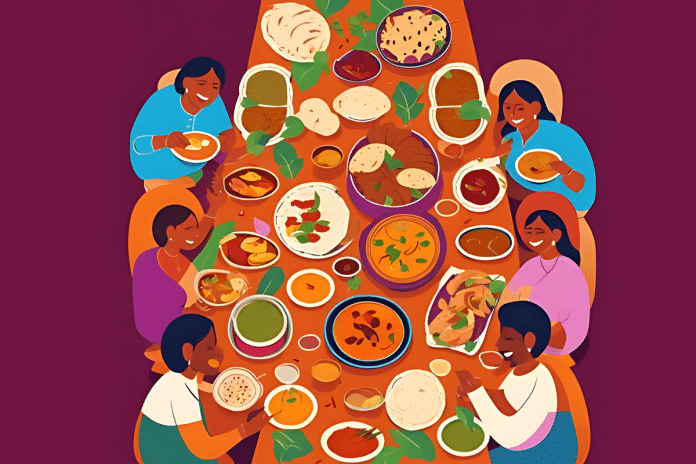FLAVOURS OF NORTHERN INDIA
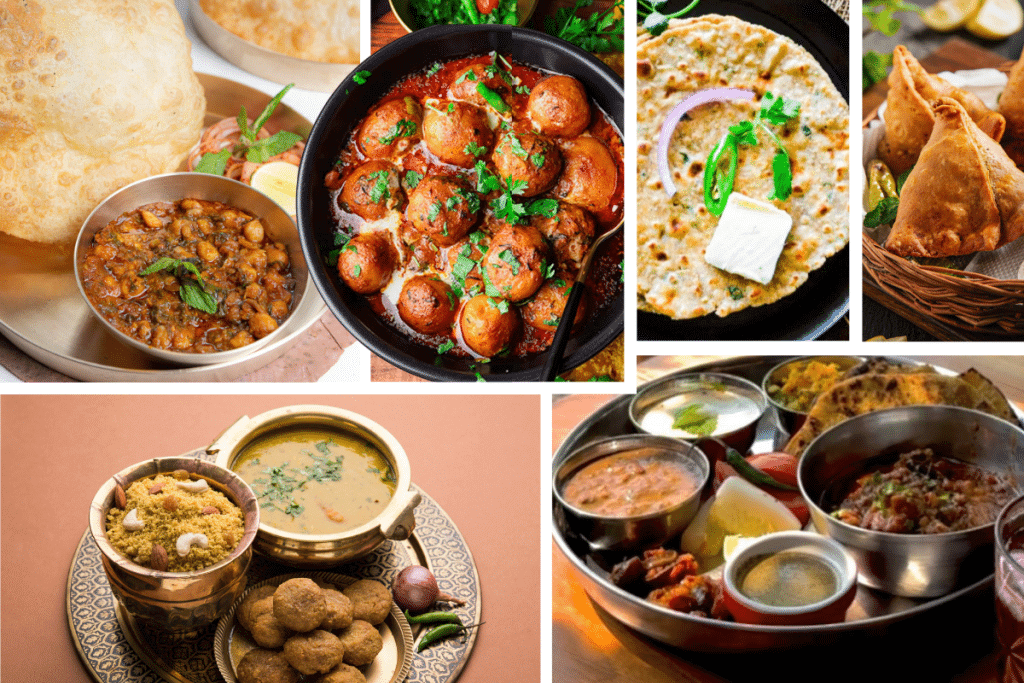
Tanvi Mor, VIC

India tastes like a rich tapestry of traditions and heritage weaving together vibrant festivals, timeless folk arts and rustic landscapes. My favourite childhood memories are celebrating the monsoon festival Teej with my mother and friends in our Haryanvi community; wearing traditional green and red attire, joyous dances, planting trees and melodious folk songs. I adored the swings hung from lush green trees amidst mustard fields and the festive charm of adorning my hands with henna. Now in Melbourne, I still wander in search of the authentic taste of bajra (pearl millet) roti, spicy kachri (wild cucumber) chutney and white makhan (butter).
Neha Jain, NSW
 India tastes like a symphony of spices and traditions, where every bite tells a story. For me, a Punjabi raised abroad, it’s the tangy burst of chole bhature (chickpea curry with deep fried bread) from the dhabas (roadside restaurant) in Punjab and the comforting sweetness of my grandmother’s homemade besan burfi (gram flour sweet), each piece a memory of her loving hands crafting it. My last visit to India was to Punjab, where I fulfilled my dream of visiting the Golden Temple. The experience was brilliant, and I still savour the taste of karha prasad (sweet offering) from that visit. Now, both chole and karha are permanent fixtures in my cooking, each dish bringing back fond memories of the flavours and experiences of India.
India tastes like a symphony of spices and traditions, where every bite tells a story. For me, a Punjabi raised abroad, it’s the tangy burst of chole bhature (chickpea curry with deep fried bread) from the dhabas (roadside restaurant) in Punjab and the comforting sweetness of my grandmother’s homemade besan burfi (gram flour sweet), each piece a memory of her loving hands crafting it. My last visit to India was to Punjab, where I fulfilled my dream of visiting the Golden Temple. The experience was brilliant, and I still savour the taste of karha prasad (sweet offering) from that visit. Now, both chole and karha are permanent fixtures in my cooking, each dish bringing back fond memories of the flavours and experiences of India.
Aman Pabla, NSW

India tastes like winter in a Punjab village; I grew up in Botswana, but each December my family travelled back to India. Warm, caramely gur (unrefined sugar), freshly reduced from ganne ke ras (sugar cane juice), the distinctive mineral aftertaste from the giant iron karahi (pan) it’s cooked down in. Eating it fresh, roadside, by the fields of green sarsoh (mustard). Silky sarsoh ki saag (mustard and greens curry) on crispy makki ki roti (flatbread), dolloped with luscious white makhan (homemade butter), with a side of crunchy, pungent mooli (radish). Smoky mah ki daal (black lentil daal), earthy from the matki (clay pot) it’s been slowly simmered in all day on the chulha (earthen stove).
Vijay Kumari, NSW
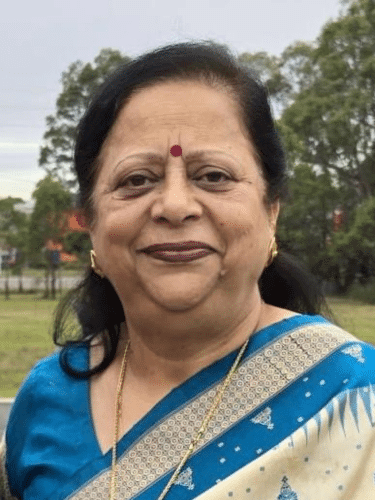
India tastes like the delectable Kashmiri dum aloo – a spiced potato curry, made lovingly by my father. It reflects the care and attention he put into preparing this slow-cooked comfort food. Even now, years later as I prepare it for my children and grandchildren I am overwhelmed to see their eager eyes waiting to savour the dish. Dum aloo doesn’t just represent a tradition; it symbolises the warmth and familiarity of home. The flavours carry with them the comforting memories of the Dal Lake, Pahalgam, Nishat Bagh and our ancestral home in Kashmir, making each bite a reminder of our roots and heritage.
Nazish Fatima, VIC

India tastes like adventure! Delhi’s street food is like culinary roulette, especially chaat and dahi bhalla (fried dumplings in yogurt). Chaat is Delhi’s way of saying, “Why settle for one flavour when you can have a whole circus in your mouth?” It’s a tangy, spicy rollercoaster that’ll make your taste buds question their life choices, but you’ll still be reaching for more. Dahi bhalla is a hug for your stomach, wrapped in a blanket of yogurt and topped with a symphony of chutneys and spices. Since moving to Australia, my taste buds do the cha-cha every time I think about those magical street corners of Chandni Chowk or Lajpat Nagar, full of edible chaos.
Sanskriti Kaul, VIC

India tastes like nostalgia, a journey back to the first fragrance of the soil after a refreshing rain in Delhi. As a child, this earthy scent would pull me outside, where I’d enjoy the rain, dancing with pure joy. The raindrops felt like nature’s own rhythm, each splash a note in a melody of pure happiness. I remember the thrill of muddy feet and soaked clothes, my heart leaping with every step and twirl. The rain was more than just water; it was a symphony of freedom and childhood wonder, forever etched in my memory.
Khagesh Maheshwari, VIC

India tastes like Daal Baati Choorma – you can’t travel Rajasthan’s slippery sand dunes without it! The Panchrangi Daal is a concoction brewed with five different lentils, a heady mix of flavours. Baati is a super-sized golf-ball of wholewheat dough roasted in a wood-fired chula (oven), then dipped in a pool of ghee (clarified butter) to soften it from the inside so that you can easily break into pieces, dip it in daal and eat! Some of the baatis are shredded by hand or with a grinder and mixed with gud (jaggery) powder to make ‘choorma’, the royal sweet!
Garima Mahantan, NSW
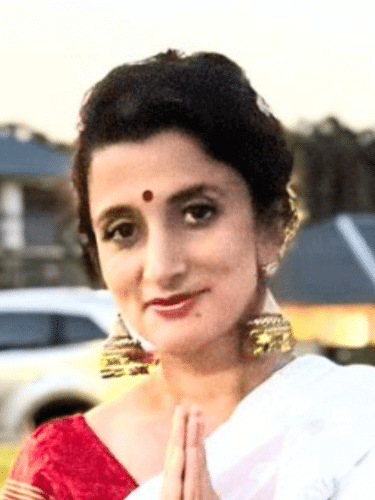
India tastes like being amidst the majestic Himalayas with breathtaking landscape on cold winter morning and being served the warm, fluffy steamed bread siddu with desi ghee by my mum. Himachali cuisine reflects the unique geography, climate, and cultural influences of the region. Dishes like madra, jhol, patrode, babbru, chukh, chutneys offer a tantalizing array of flavours, textures, and aromas that delight the senses. Memories of family gatherings during festivals and celebrations where Dham (a traditional multi course meal) are enjoyed, often accompanied by traditional rituals and community spirit. Himachal food for me is characterised by its simplicity that fosters a deep sense of contentment and connection.
FLAVOURS OF CENTRAL INDIA
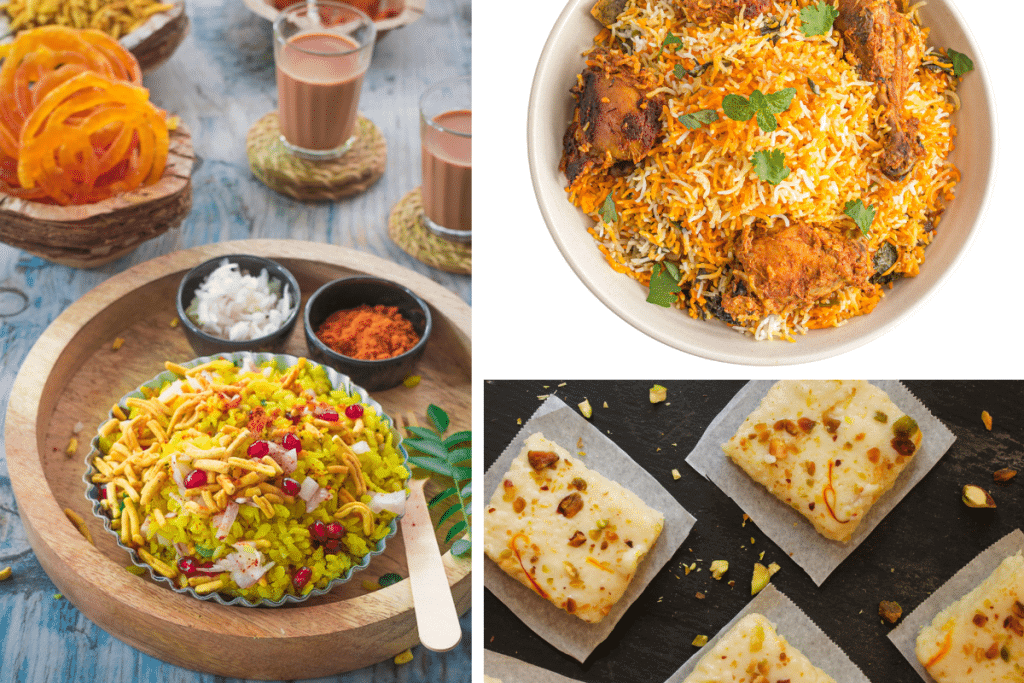
Navishkar Asitosh Ram, NSW

India tastes like the rich mix of spices that dance in your mouth when you take that first bite of biryani. It sometimes also tastes like the hard crunch of an elaichi (cardamom) shell when sifting through the layers of saffron-infused rice. The land is rich and teeming with colour and sweetness, and that same sugary delight is sampled in the syrup of my mother’s gulab jamun (sweet dumplings) or in the sandy roughness of my nani’s ghojia (sweet filled pastries). The flavours of Lucknow and of Uttar Pradesh, enjoyed hundreds of kilometres away on the far-flung beaches of Fiji.
Santosh Gupta, ACT

India tastes like kalakand, a sweet made of milk, like Italian cheesecake, found in every corner of Uttar Pradesh. Since my childhood, I have loved this sweet, the simple ingredients make it seem like a very authentic and healthy dish to me. Kalakand is very easy to make at home on special occasions such as Deepavali, Raksha-Bandan and Bhai-Duj festivals. Even here in Australia, I always look for this in the sweet shops. Kalakand was my father’s favourite sweet of them all, and my son too likes this; taste is a legacy passed down generations.
Abbas Raza Alvi, NSW

India tastes like hot crisp samosas (savoury filled pastry) enjoyed with your dear ones! Over my 35 years in Australia, I’ve dined at different places selling samosas, yet I’ve never found the taste that matches that of my birthplace on the bank of the Ganges. After school, my friends and I would savour freshly fried samosas, served on pattal (leaf) plates, drizzled with chatpati sweet sour chutney – they were irresistible, the perfect snack to satisfy our innocent cravings. There was something undeniably magical about those samosas; the vendor was always in demand, his stall brimming with the lively chatter of children. Even after all these years, I long for that hot, crisp, flavourful bite!
Maneet Hora, VIC

India tastes like Sunday’s poha (flattened rice) and jalebi (deep fried sweet). It was a tradition in our home in Indore to begin Sundays with poha, yellowed with haldi (turmeric), paired with sizzling newspaper jalebi soaked in the oil it had just swum in – it put the ‘Sun’ in Sunday. I miss sitting with my grandfather on Sunday morning, the one day he’d take a break from his turban to wash his hair. The clanking of his spoon against the plate as he gathered the last of the poha was something to savour. Now, I sit with my parents in Australia, but our Sundays still taste of poha and jalebi.
Neelam Vasudevan, VIC
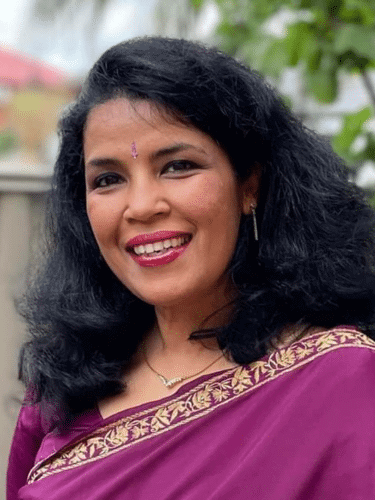
India tastes like the fresh cool breeze of the mountain ranges. Kumaoni (pahadi) food brings beautiful memories of a childhood that tasted delightful – rich, tangy, spicy, sweet, pure, and above all, rare! Aloo ke gutke (potato fry), slow cooked bhatt ki churkani (black soy beans) or kadhi badi (yogurt-based curry), ras (dal), kaapha (spinach), chainsu (black gram) and kheere (cucumber) ka raita – all food for my soul. The tanginess of the chutneys, sanaa hua nimbu (lemon raita), mooli ki thechwani (mashed radish curry), kafal and hisalu berries! My sweet tooth remembers balmithai (caramel fudge), arsa (rice flour, jaggery and sesame), gulgula (fritters), singodi (khoya) wrapped in malu leaf, jalebi doodh (deep fried sweet in milk). Simple, unique and unforgettable!
FLAVOURS OF WESTERN INDIA
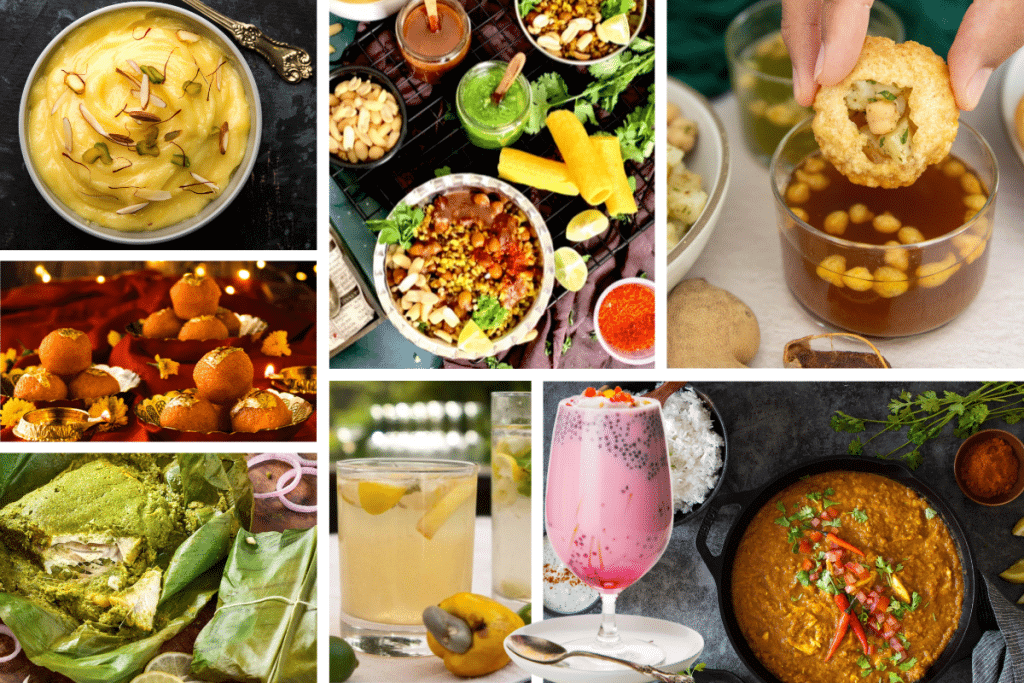
Zenobia Aderbehman, VIC

India tastes like nostalgia. The aroma of sheek boti (meat kebabs) roasting outside the Bandra Station in Mumbai. I grew up eating dhansak (curry), along with fried fish, kebabs, full boiled eggs and kachumber (cucumber salad) every Sunday – it’s a ritual in many Zoroastrian homes. Tarapori patia pickle made of dried Bombay ducks in spicy gravy just makes my mouth water and my forehead sweat. And how can I ever forget our Parsi weddings and Navjote, the dinner is something to experience and relish ten times over – especially that all-time favourite Patrani machi, fish coated with green spicy chutney wrapped in banana leaves – and culminating with sweet paan (betel leaf) and pistachios to refresh your palate.
Preeti Thadani, NSW

India tastes like my childhood’s sweetest treat, kulfi-falooda (ice cream drink). After Sunday family dinners at my nani’s (grandma’s) home in Breach Candy, Papa took us for a Victoria ride (horse-drawn carriage) on Marine Drive, to enjoy Bombay’s famous dessert. The Queen’s necklace (Marine Drive) was as special as the slippery glass noodles topped with cold creamy, nutty kulfi (ice cream) in aromatic rose-milk interlaced with sabja (basil seeds). Each spoonful of wriggling noodles felt like a sweet angel’s dance in my mouth. The outside traffic chaos disappeared into oblivion as I watched the melting kulfi raise the liquid quantity in my glass. It felt like my treat would go on forever.
Sneha Khale, QLD

India tastes like childhood. It doesn’t matter how old you are – every taste of India is rooted in nostalgia. Visits to my favourite chaat (street food) joints in Mumbai remind me of outings with high school friends, the neighbourhood aunties still view me as a besan laddoo-loving kid (gram flour balls), and mum insists on making all my childhood favourites – puranpoli (sweet flatbread), shrikhand (sweet yogurt), sitafal (custard apple) ice-cream, biryani (mixed rice). The decidedly fashionable Bombay Canteen feels like a throwback: the fusion thukpa (noodle soup) like the one I enjoyed on that ‘90s Himalayan family trip, even the illustrations on their menu are reminiscent of R.K. Laxman’s cartoons that I loved as a child.
Veena Nair, VIC
 India tastes like cohesion within chaos. It’s the taste of tamarind, chillies, and the boondi (fried chickpea balls) in the pani (water). It tastes of crisp puri (deep fried bread), and as you take this cacophony of flavour in, you realise it also tastes of you. Of your fingertips, pushing the chaat (street snack) into your mouth with the urgency of a scooter filtering through lanes of rickshaws. In the sweetmeat stalls it can taste of celebration and in the family kitchen it can taste like love, but to those who know her, Mumbai tastes of home.
India tastes like cohesion within chaos. It’s the taste of tamarind, chillies, and the boondi (fried chickpea balls) in the pani (water). It tastes of crisp puri (deep fried bread), and as you take this cacophony of flavour in, you realise it also tastes of you. Of your fingertips, pushing the chaat (street snack) into your mouth with the urgency of a scooter filtering through lanes of rickshaws. In the sweetmeat stalls it can taste of celebration and in the family kitchen it can taste like love, but to those who know her, Mumbai tastes of home.
Krushnadevsinh (Kano) Ravalji, VIC

India tastes like bhungda bateka, a combination of crispy yellow bhungda (fryums) and spicy, flavourful bateka (potatoes), a specialty from Bhavnagar, Gujarat, where I spent the first seven years of my life before moving to Australia. Although my time was brief, the memories remain strong, and my connection to the culture and land continues to evolve as I grow up here, always drawing me back to reconnect with my roots. Just like the addictive crunch of bhungda and the spicy charm of the bateka, the thought of India makes my mouth water, leaving me longing for just one more bite or trip.
Ujas Patel, NSW

India tastes like prasad (offering). Growing up in a joint family where each member had their personal favorite temple, we would often visit temples back-to-back. As we went from one to another, the focus shifted from darshan to prasad. Come on, it’s hard to concentrate on prayers with a half-broken boondi ka laddoo (gram flour balls) staring at you! After a quick pradakshina (clockwise circling of deities), I’d grab a small piece, trying to be modest, but secretly plotting to steal more from my younger sister. The taste of that prasad brings back fond memories of home, family, and the joyous rituals that connect me to India.
Frankey Fernandes, VIC

India tastes like Goan feni (liquor). A trip to Goa is incomplete if you haven’t tried the feni; be it coconut feni or cashew apple feni, no one who has visited Goa dare say they haven’t tried it! The aroma of cashew feni is so strong that it can be smelt far away from the place of its distillation. Drank mostly in the villages, it’s best consumed under the hot sun on the beach, and if taken neat, can be too intoxicating to stay conscious! So when in Goa, do not forget to have a sip of feni – but drink in moderation.
FLAVOURS OF EASTERN INDIA
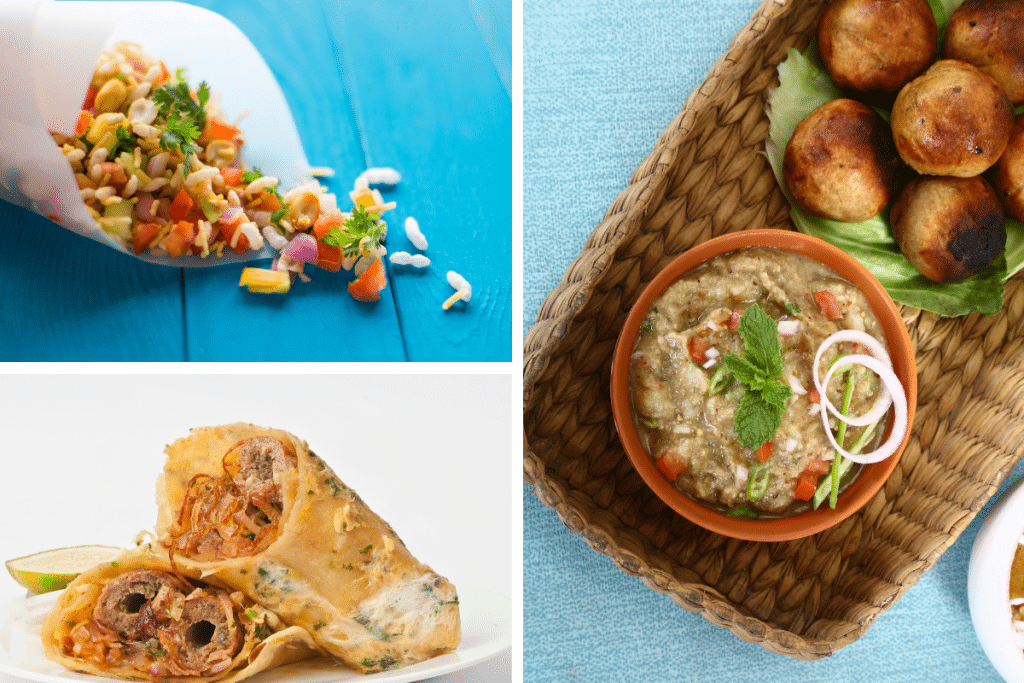
Meena Mahanty Kumar, NSW

India tastes like the sweet cream rolls and savoury kathi (kebab) rolls in my hometown Jamshedpur. Memories of spending the afternoon waiting impatiently for the Howrah bakery man with his trunk full of goodies still make my mouth water. Of course, the cream roll was king! I still haven’t found anything as good here in Sydney and believe me I’ve looked everywhere. The taste of India for me is the memory of our family savouring chicken kathi rolls near the Bistupur library after a movie at Natraj Cinema. It’s the taste of my beloved hometown, a place I still call home.
Padmaja Jha, ACT

India tastes like tutti-frutti ice cream, a cacophony of many colours. It is that indescribable exhilaration of arriving home to the loving arms of a mother. I remember litti chokha (dough balls), sattu (roasted gram flour) paratha and tilkut (sesame rounds) in winter, and chura dahi (curd and flat rice), juicy jardaloo (apricot) and maldah aam (mango) in summer. Kachri (cucumber) remains my ultimate comfort food along with creamy makhana kheer (sweet pudding). But the one that surpasses all in taste or benefits is hara chana (green chickpeas), the ultimate Bihari cuisine, which tastes fresh and is always nutritious. It’s simple to cook; just temper panch phoron (five spice mix), turmeric and salt in mustard oil. Love is spoken through food.
Parminder Jabbal, VIC
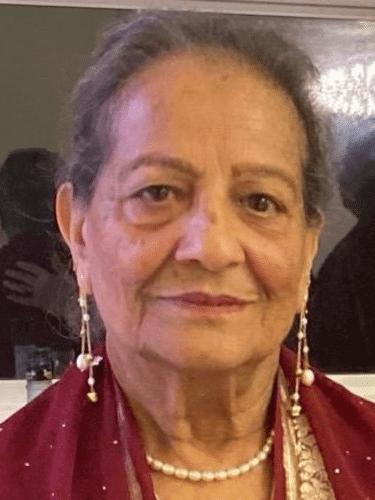
India tastes like jhalmuri, a spicy puffed rice street food commonly sold on trains during our long-distance travels from Burdwan to Kolkata. Despite its super spicy flavour, we eagerly awaited its preparation by the vendors; a mix of puffed rice, cucumber, lemon, onion, chilli, tomato, salt, potato, and spicy chanachur (mixture), bound together with just the right amount of mustard oil. It was sprinkled with fresh coriander and served in a cone made from old newspaper, a cost-effective way to recycle, like fish and chips. Time moves on, but certain memories always linger, some in our minds, some on our palate.
Also see: THE LATEST EDITION OF INDIAN LINK’S INDEPENDENCE DAY ISSUE
FLAVOURS OF NORTHEAST INDIA
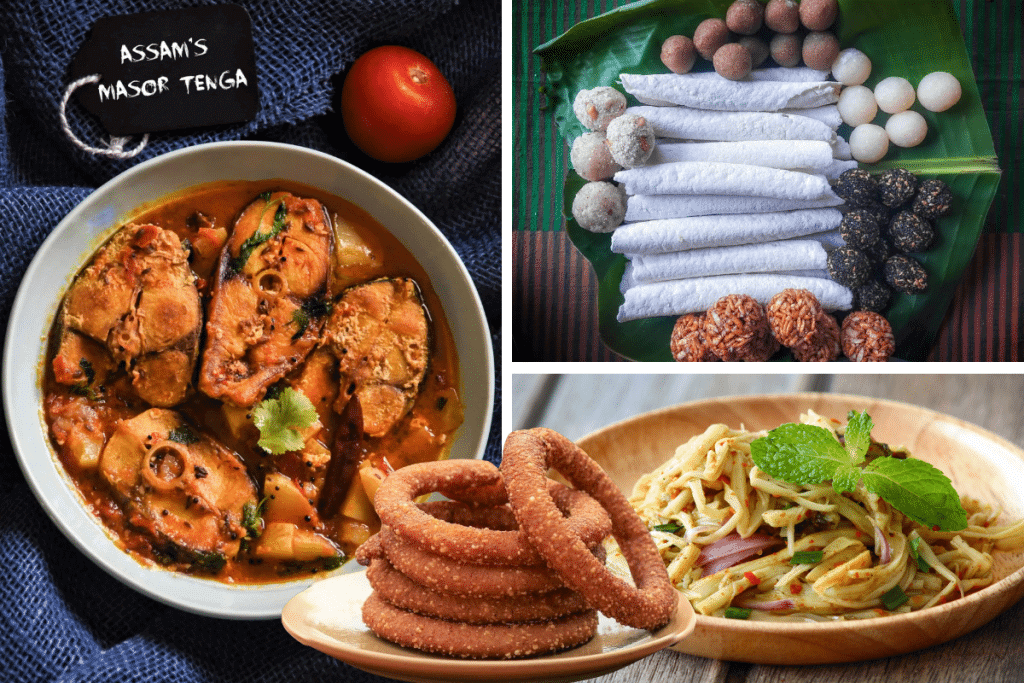
Matana Pachuau, NSW

India tastes like a rich blend of exotic and aromatic spicy food. But here’s an option if you’re like me and prefer it less spicy. I live in Sydney, but I come from the bamboo forest state of Mizoram in northeast India. Arguably, the most traditional dish is made from bamboo shoot! Tender bamboo shoot prepared in various ways from simply boiled to spicy pickles are a staple in that part of the country. This nutritious food is ubiquitous and virtually every home you visit will offer you one at dinner time.
Indrani Kakoty, NSW
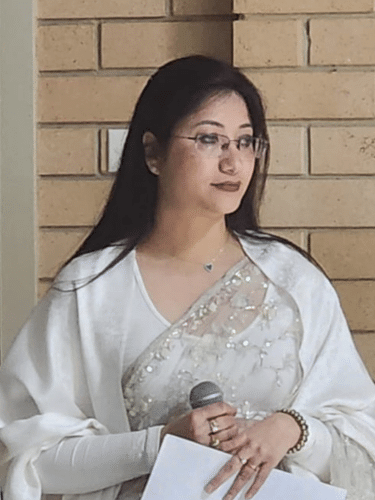 India tastes like nature, the ‘cotton candy’ of the clouds. The deliciously untouched beauty of the hills, the sweet echoing music, seasoned with droplets of rich cultural heritage. ‘The Abode of Clouds’ as this place is known, Meghalaya one of the most beautiful, naturally blessed and culturally diverse states of India. The stunning Meghalaya is noted for its lush landscapes, unbelievable waterfalls, and rich indigenous cultures. Blessed with unique craftsmanship, dance, music, and cuisine, this place has a lot to offer.
India tastes like nature, the ‘cotton candy’ of the clouds. The deliciously untouched beauty of the hills, the sweet echoing music, seasoned with droplets of rich cultural heritage. ‘The Abode of Clouds’ as this place is known, Meghalaya one of the most beautiful, naturally blessed and culturally diverse states of India. The stunning Meghalaya is noted for its lush landscapes, unbelievable waterfalls, and rich indigenous cultures. Blessed with unique craftsmanship, dance, music, and cuisine, this place has a lot to offer.
Mridusmita Haloi, VIC
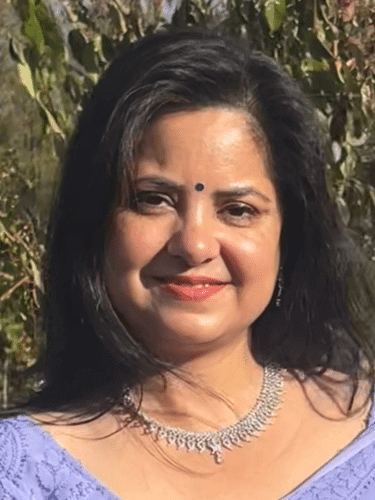
India tastes like the signature Assamese dish of bhat and masor tenga (rice and sour fish curry) with a slice of lemon and a green chilli on the side. Cooked with fresh river fish and organic local produce, this tangy, flavourful dish is easy on the palate, nutritious and supremely satisfying. It’s funny how I realised this only after I came to Melbourne twenty years ago – I suffered from masor tenga withdrawals from time to time! I find the frozen fish here tasteless and vegetables foreign… and where is the kaji nemu (lime)?! Most importantly, where is Ma!
Bedashree Gogoi, NSW
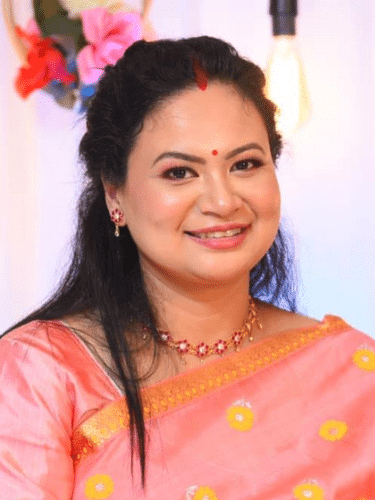
India tastes like til pitha (sesame pancake), quintessential in every Assamese household. Served on a platter during Bihu with other sweets, it’s made from bora saul (glutinous rice), which is ground, rolled and filled with sesame and jaggery. Though requiring only a few ingredients, it’s tough to master the art of making these delectable beauties; the key is having the right pan temperature. When Bihu arrives, my desire to have til pitha with a cup of tea grows, but the rice is hard to get in Sydney; each time I visit home, I relish my mother’s til pithas.
Ranjita Sharma, NSW

India tastes like the vibrant flavours of Sikkim; its snow-capped peaks and lush green valleys. Sikkim’s cuisine is hearty and wholesome, influenced by Tibetan, Nepalese, and Bhutia traditions – one of the signature dishes is momos, steamed or fried dumplings filled with minced meat or vegetables, served with a spicy tomato-based chutney. Another staple is thukpa, a warm noodle soup brimming with vegetables, meat, and aromatic spices. Gundruk (fermented leafy greens) and kinema (fermented soybean) add a distinct tangy flavour, and sel roti, a ring-shaped rice bread, is a popular festive treat. It’s a charming and fresh taste which has left a lasting impression on me.
FLAVOURS OF SOUTHERN INDIA
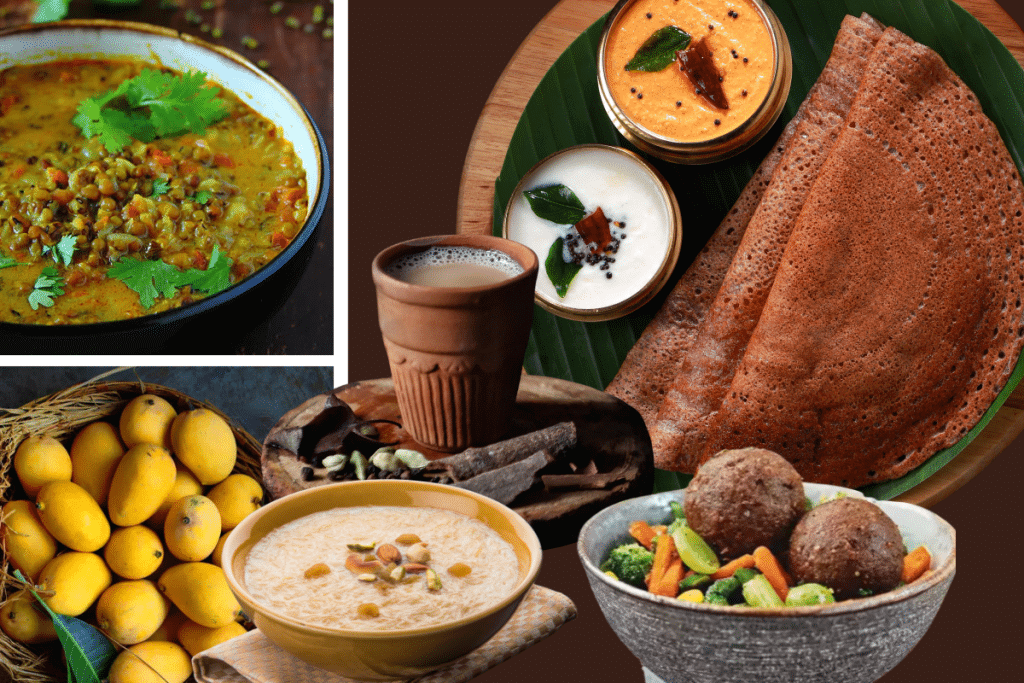
Amitav Goswami, NSW

India tastes like a school break after the final exam. Frequenting Chennai three to four times a year now, the development of the state astounds me, the humility of the people moves me and the food – both at home and in restaurants – leaves me full! The development of the country is at a very fast pace and it’s nice to see the smiles are still there on the streets. The hustle bustle, caring attitude and acceptance of life are amazing.
MEGHNA, VIC

India tastes like the warm, fresh, fragrant payasam (sweet pudding) lying loose in a plastic bag given to us by priests after a family visit to the temple. The aroma of cardamom would permeate the car air as we drove to a nearby restaurant for a post-temple feed, where we would be served fresh, crispy dosa with MTR sambar (lentil stew) and potato masala. If I was lucky, I would be able to grab bhel puri (puffed rice snack) as well and would eventually have to share it with my dalmoth (mixture) and chaat (street snacks) obsessed Bengali father.
Abhirami Viju, NSW

India tastes like cherupayar (mung bean) curry, one of the many staple dishes Amma hopes I’ll learn to make solely by watching her, despite my culinary ineptitude. I’m flustered when she asks me to add the uppu (salt), manjal (turmeric) and molagu (chilli) — the three tenets of all her cooking, intuitive amounts forever unspecified. We eat; I use my hand to mix the warm, softened, brown cherupayar beans into the long grains of white rice. The manjal stains my hands the colour of maanga (mango) despite my handwashing, filling in the spaces between the lines of my fingerprints.
Lakshmi Ganapathy, VIC

India tastes like masala dosa. On our family visits to Guruvayur, we’d find ourselves at a roadside cafe specialising in wafer thin dosa (fermented crepe), folded over a tangy but comforting masala potato filling – I used to drag my feet there, as after a whole two weeks of bouncing from temple to temple, my childish palate longed for the pasta and pizza it was familiar with. But now that I’m older, I can’t help but smile at those cute spicy potatoes ensconced in their little blanket! They make me feel the warm embrace of the banana leaves in cold Melbourne.
Manoj Kumar Hosahalli, VIC

India tastes like the amazing combination of ragi mudde (millet ball) and lentils curry, one of the staple foods in Karnataka that’s often ignored by today’s generation. Being from a farmer’s family, it’s always been imposed on me to have it at least once a day, which made me hate it to the point of boycotting it! But now I miss it so much that I’ve mastered the art or preparing it so I can introduce it to my friends here in Melbourne. It reminds me of my roots and the wonderful times I have had on our farm.
Trisha Mathur, NSW
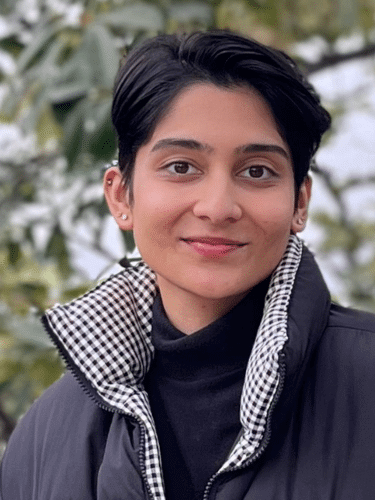
India tastes like the enchanting warmth of the first sip of chai (spiced tea) that rolls down your throat, wrapping around you like a cozy blanket and filling you with a sense of ethereal calm and comfort. It tastes like the aroma of boiling tea leaves, ginger, a hint of cardamom, and bubbling anticipation. It’s the icebreaker at every awkward family function or a bond strengthener at a gossip session. India tastes like the sentiments that cannot be evoked by the same tea at chai time. India tastes like the million hyper-specific ways that Indians like chai. Chai tastes like home.
Bhavya Vemulapalli, VIC

India tastes like Andhra’s mangoes that get exported across the world! Andhra and Telangana top the charts in terms of sending students abroad too. Ironically, we all tend to adapt and improvise so much that we forget the ‘original’ recipe. Eventually, it gets to a point where mangoes go with everything but aren’t a ‘stand-alone’ obsession — such is the idea of belonging. We carry what came before us, and carve what’s ahead, but somehow can’t express what we truly are. Anywho, while I question it all, let me quickly freeze some more mangoes for all the seasons to be!
Read More: Indian Independence Day: Intimate tributes from community




